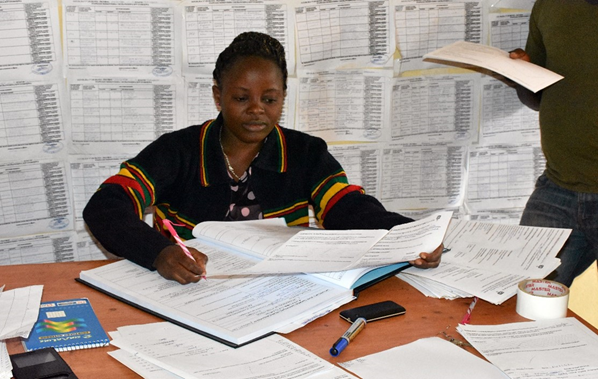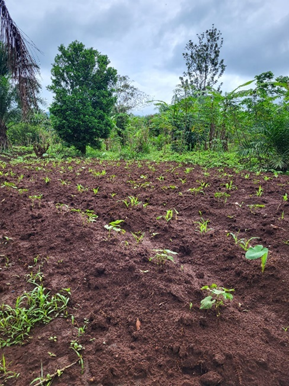Burundi has the world’s highest hunger score and around 45 percent of the population is affected by food insecurity. The country copes with increasing scarcity of land as a result of increasing population size, returnees and IDPs and climate change. With the majority of Burundians depending on agriculture for their food and livelihoods, land scarcity makes this reliance on agriculture precarious. This pressure on land causes elevated levels of land disputes with over 55% of all court cases being related to conflicts over land. The results of these disputes are often highly uncertain, as land is commonly not registered and no good documentation of ownership or use rights exists.
ZOA has successfully implemented Land Tenure Registration projects in the Makamba-province, but the sustainability of the local land offices (SFCs) remains an issue, as well as guaranteeing gender equality in land governance. The objective of the LAND-at-scale project is to improve tenure security of women and men, conflict resolution and to create the basis for improved agricultural production, access to justice and sustainable, climate smart agri-businesses.
Our knowledge partner Neil Sorensen (Land Portal Foundation) interviewed Minani Servillien and Annonciate Twagirayezu from ZOA Burundi on their experience in upscaling their pilot project.
How do you define scaling and what does it mean in your project? If you had to define your scaling ambition in your project, what would it be?
“We are expanding our efforts to scale up the group recognition approach for land certification beyond Makamba province, extending it to other intervention zones. This involves systematically certifying people's land in provinces other than Makamba. Additionally, scaling up entails implementing complementary activities to enhance the effectiveness of our interventions.
At ZOA, we have prior experience with land certification within our organization. However, we need to broaden our scope by incorporating other complementary activities. For instance, in our current intervention zone, our focus has primarily been on land certification. However, we recognize the importance of transitioning to an approach that not only promotes efficient land utilization for increased agricultural production but also encompasses various aspects that support households in utilizing the land effectively.
Our primary goal is to extend our coverage to the neighboring provinces of Makamba province, taking into careful consideration the upcoming administrative division changes in Burundi, set to be implemented by 2025. With Makamba designated as the capital of Makamba Province, it is prudent to prioritize expansion efforts in the provinces that will fall under its jurisdiction, namely Rutana, Bururi, and Rumonge.
Furthermore, we have an additional objective. Within our intervention zone, prior to implementing the project's land certification using the systematic approach and the group approach, various conflicts had emerged, particularly land disputes between private individuals and the state. Hence, it is our strong aspiration to ensure that these conflicts are effectively resolved during the project implementation phase.”

What elements could prevent you from achieving your scaling ambition?
“The work involved in this project is highly expensive due to several essential steps. Firstly, it necessitates the identification and demarcation of public lands to safeguard them against unauthorized claims. Subsequently, the measurement and certification of private lands must be conducted, leaving no parcel unaccounted for. This comprehensive undertaking requires significant allocation of human, material, and financial resources, contributing to its overall cost.
In addition to the substantial financial requirements, another challenge stems from the absence of appropriate land management regulations. This lack of legal framework further complicates the project's execution and amplifies its scope. Moreover, our current resources are primarily designated for the Integrated Farm Plan (PIP) approach, which demands substantial financial backing. However, out of the 26 areas covered by the project, we have only been able to implement the PIP approach in eight locations. Therefore, obtaining additional funds would enable us to extend the application of this approach to all project areas.”
What would your ideal scaling ambition be?
“Our ideal scaling ambition is to ensure land security across Burundi by adopting a collaborative approach that emphasizes recognition, the establishment of a comprehensive land information system, and its consistent maintenance and updates. Additionally, we aim to promote the profitability of secure land ownership, enabling landowners to enhance their household well-being significantly.”
“We aim to promote the profitability of secure land ownership, enabling landowners to enhance their household well-being significantly”
What challenges and bottlenecks do you see in your current context that are hindering this ambition?
“First and foremost, it is imperative to address the pressing issue that a comprehensive national land policy document, which serves as a guiding framework for desired interventions and reforms, is still absent. This void undermines effective decision-making and hinders progress in this critical area. Secondly, an alarming concern arises from the government's continued dependence on external funding for land security initiatives, as there is a lack of a dedicated budget in this regard. This reliance poses significant risks and limits the autonomy and sustainability of efforts aimed at ensuring land security for the populace. Thirdly, the current ministry responsible for land affairs inadequately handles the intricate disputes between the state and its citizens, perpetuating an environment of insecurity and vulnerability.
A more proactive approach is needed to swiftly resolve these complex disputes, prioritizing the well-being and safety of the population. Moreover, the absence of a community development plan further exacerbates the situation, impeding the realization of the people's aspirations within the broader framework of population development. It is crucial to establish and implement a comprehensive community development plan that aligns with the population's visions, fostering inclusive growth and sustainable development.”
What would be your definition of sustainability and achieving structural change? What can project implementers do to ensure sustainability when it requires the sustainability of systems and changes in behavior that are not entirely within your control?
“In order to address the issue at hand, we should implement two key actions, one focused on the upstream aspect and the other on the downstream aspect. In the downstream phase, our primary objective should be to enhance awareness regarding land management practices and foster a shift in behavior. This can be accomplished through various means such as educational campaigns and initiatives aimed at altering current practices. Additionally, we need to concentrate on bolstering the expertise of technical personnel involved in land management at the AMO level. It is through the development of their capabilities that we can effectively instigate changes in practices at the technical level. These changes will, in turn, have a significant influence on the political authorities, although it is important to note that their behavior lies outside our direct control. By showcasing the successes achieved at the technical level, we can influence the political authorities, resulting in altered approaches to the issue at hand."
By showcasing the successes achieved, we can influence the political authorities
Moreover, it is imperative to organize workshops and forums for dialogue with the administrative staff responsible for decision-making. As demonstrated by our previous endeavors in late 2022, we successfully conducted a national conference that brought together all relevant stakeholders to contribute their insights. Representatives from the ministries responsible for land matters were also present, facilitating fruitful exchanges and enabling them to absorb the message effectively. Such platforms for exchange serve as catalysts for transformative changes within the decision-making process.”
How does inclusivity materialize in your project and activities? RVO has also included inclusive approaches and multi-stakeholder engagement as factors for sustainability. Do you agree with this? And how does this materialize in your project strategy and activities?
“The project exemplifies inclusivity in multiple ways. Firstly, at the field level, it primarily focuses on conducting a land survey in the hills of Natal. This survey work is carried out by community staff hired from the local community's land department, ensuring that the project involves and benefits the community directly. Additionally, support staff is provided to assist in various project activities.
Meanwhile, the support staff also play a crucial role in progressively enhancing the capacity of the community staff. Furthermore, in terms of inclusivity, the certification process takes into consideration the land rights of vulnerable individuals, including those with disabilities. No plots are left out, ensuring that everyone's land rights are acknowledged. Moreover, the project acknowledges and upholds women's rights by systematically issuing land certificates for all non-conflict population-owned land.
In order to foster inclusiveness, raising awareness among the population is of utmost importance. At the community level, a partnership agreement exists between ZOA and the community administration, ensuring that the community is well-informed about all planned activities and actively involved in the planning process. Planning meetings regularly include the community administration, their advisors, and the municipal land department staff, keeping both the local population and the municipal administration updated on the project's progress. Capacity-building workshops and training sessions have been organized, including sessions for judges and lawyers to familiarize them with the land certification process and the significance of the resulting documents, namely land certificates. Furthermore, a national conference was convened to invite all stakeholders involved in land tenure security, providing them with insights into the project's objectives and current requirements.
In addition to these efforts, an exchange group called "groupe sectoriel foncier" is being established to facilitate discussions on necessary changes for improving land tenure security. It is worth mentioning that the recognition of plots and validation of ownership is carried out by the hill commissions.”

We have the urgency of the 2030 Agenda. LAND-at-scale wants to promote holistic and responsible scaling. What do you think needs to be done to move things forward?
“The government's proactive role is crucial in leading the way. When land security becomes the government's top priority, it paves the path for success in all endeavors. However, if the government constantly lags behind due to leases and financial partners, issues of ownership will persist. Thus, it is imperative for the government to assume a leading role in the scaling-up process.
To begin with, it is essential that all stakeholders involved, including those in Burundi, share a unified vision of the necessary changes. Without this shared understanding, organizations like ZOA will struggle to expand their efforts. Additionally, collaborating with various actors, be they governmental or private, must also be considered.”



